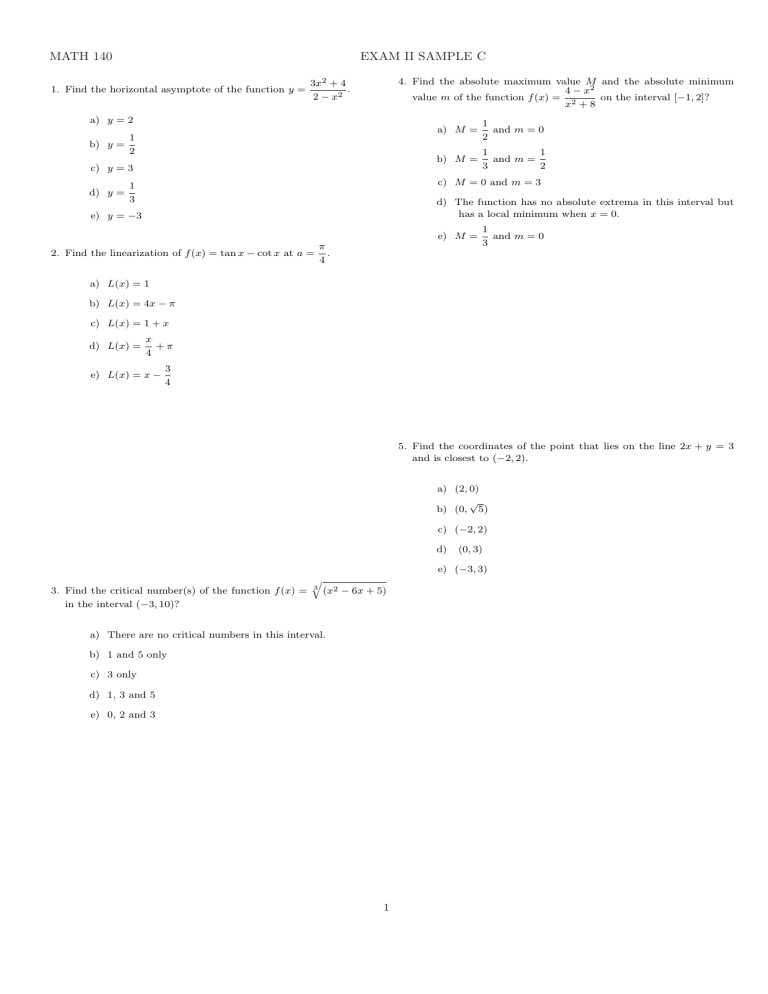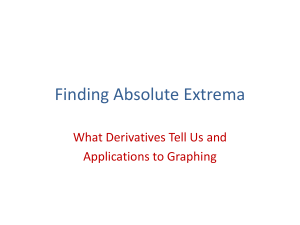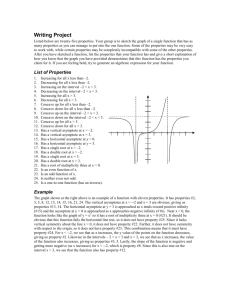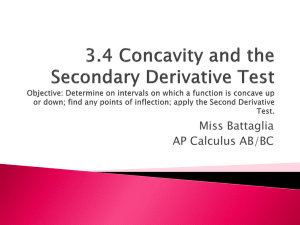MATH 140 EXAM II SAMPLE C
advertisement

MATH 140 EXAM II SAMPLE C 1. Find the horizontal asymptote of the function y = 4. Find the absolute maximum value M and the absolute minimum 4 − x2 value m of the function f (x) = 2 on the interval [−1, 2]? x +8 3x2 + 4 . 2 − x2 a) y = 2 1 b) y = 2 c) y = 3 d) y = a) M = 1 and m = 0 2 b) M = 1 1 and m = 3 2 c) M = 0 and m = 3 1 3 d) The function has no absolute extrema in this interval but has a local minimum when x = 0. e) y = −3 e) M = π 2. Find the linearization of f (x) = tan x − cot x at a = . 4 1 and m = 0 3 a) L(x) = 1 b) L(x) = 4x − π c) L(x) = 1 + x d) L(x) = x +π 4 e) L(x) = x − 3 4 5. Find the coordinates of the point that lies on the line 2x + y = 3 and is closest to (−2, 2). a) (2, 0) √ b) (0, 5) c) (−2, 2) d) (0, 3) e) (−3, 3) q 3. Find the critical number(s) of the function f (x) = in the interval (−3, 10)? 3 (x2 − 6x + 5) a) There are no critical numbers in this interval. b) 1 and 5 only c) 3 only d) 1, 3 and 5 e) 0, 2 and 3 1 MATH 140 EXAM II SAMPLE C 6. Determine a value of c that satisfies the Mean Value Theorem for 4 the function f (x) = 5 − on the interval [1, 4]. x a) c = 1 a) (−3, 1) b) c = 4 c) c = 2 3 x + 2x2 − 6x + 11 find the interval for 3 which the function f is concave downward. 9. Given the function f (x) = b) (−∞, −3) 1 2 c) (−∞, −1) d) c = 2 d) (1, ∞) e) There is no value c on [1, 4] that satisfies the Mean Value Theorem. e) (−1, ∞) 10. Find lim x→∞ p 4x2 + 4x − 2x a) 0 b) 1 c) 2 d) 4 e) ∞ 11. Find an equation of the slant asymptote of the graph of f (x) = 2x2 + 16 . x−3 7. Find the interval(s) on which f (x) = (x2 − 4)2/3 is increasing. a) y = 2x − a) (−∞, 0) b) y = b) (0, ∞) 8 3 34 x−3 c) (−∞, −2) and (2, ∞) c) y = 2x + 6 d) (−2, 2) d) y = 2x − 6 e) (−2, 0) and (2, ∞) e) y = 2x x 8. If f (x) = x3 − x2 − x + 1, which one of the following statements is 12. Find any local extrema for f (x) = sin x − on the interval [0, π]. 2 true? a) A local maximum for f occurs at 0. a) An inflection point occurs when x = 1. π . 4 π c) A local minimum for f occurs at . 4 π d) A local maximum for f occurs at . 3 π e) A local minimum for f occurs at . 3 b) A local maximum for f occurs at 1 b) An inflection point occurs when x = . 3 c) A local maximum occurs when x = 1. d) A local minimum occurs when x = 1 . 3 e) A local maximum occurs when x = 1 . 3 2 MATH 140 EXAM II SAMPLE C 13. Given f 00 (x) = 1, f 0 (0) = 7, and f (0) = 3, find f (1). a) 21 2 b) 10 3 c) 17 3 d) 17 2 e) 23 3 16. (9 points) An open box having a square base is to be constructed from 48 in2 of material. What should be the dimensions of the box to obtain a maximum volume? Show all work for full credit. Questions 14 and 15 are true/false type. Mark a) for true, b) for false. Each true/false question is worth 2 points. 14. If f 0 (c) = 0, then f (x) has a local extremum at x = c. a) True b) False 15. If f 0 (c) = 0 and f 00 (c) < 0 then f (x) must have a local maximum at x = c. a) True b) False Dimensions: 3 MATH 140 EXAM II SAMPLE C 17. (11 points) Use the function and its derivatives to find the requested 18. (11 points) The figure shows the graph of the derivative f 0 of a information. Answer ”none” if applicable. function f . f (x) = 1 , x2 − 9 f 0 (x) = −2x , (x2 − 9)2 f 00 (x) = 6(x2 + 3) (x2 − 9)3 y a) The domain of f (x) is . b) The critical number(s) of f (x) is(are) . f 0 (x) c) The horizontal asymptote of f (x) is . −2 d) The vertical asymptote(s) of f (x) is(are) . −1 e) f (x) is increasing on the interval(s) . f) f (x) is decreasing on the interval(s) . g) The x-value(s) of the local maximum(s) is(are) . h) The x-value(s) of the local minimum(s) is(are) . i) f (x) is concave up on the interval(s) 0 1 2 3 . j) f (x) is concave down on the interval(s) k) The x-value(s) of the inflection point(s) is(are) . NOTE: The information requested below refers to the function f . The derivative f 0 is graphed above. On what intervals is f increasing? On what intervals is f decreasing? For what values of x does f have a local maximum? For what values of x does f have a local minimum? For what values of x is f concave up? For what values of x is f concave down? EXAM II- FORM A 1. E 2. B 3. D 4. A 5. D 6. D 7. E 8. B 9. C 10. B 11. C 12. D 13. A 14. B 15. A 16. 4”x4”x2” 17. a) (−∞, −3) ∪ (−3, 3) ∪ (3, ∞) b) x = 0 c)y = 0 d) x = −3, x = 3 e)(−∞, −3), (−3, 0) f)(0, 3) ∪ (3, ∞) g) x = 0 h) none i) (−∞, −3), (3, ∞) j) (−3, 3) k) none 18.a) (−2, 0), (4, ∞) b) (−∞, −2), (0, 4) c) 0 d) −2, 4 e) (−∞, −1), (1, 2), (3, 5) f) (−1, 1), (2, 3), (5, ∞) 4









